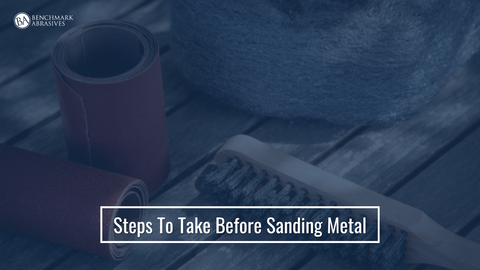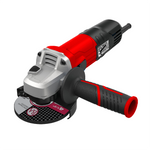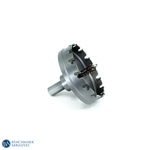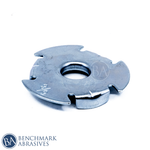
Steps To Take Before Sanding Metal

Are you familiar with metal sanding? It can take many hours to thoroughly sand down and attain the ideal finish on many surfaces, making metal sanding a laborious and time-consuming process.
You can sand metal with the same success as if you spent hours doing it by hand. This is done by carefully choosing the right sandpaper grain and using the right techniques. You can spend less time on this process while still getting excellent results. This is if you follow the detailed directions in this comprehensive guide to sanding metal.
Things To Consider While Using Sandpaper To Polish Metal
- First of all, remember that there are numerous varieties of metal. Because copper is a softer metal than steel, it can be sanded more easily. Unrelated to this, you should make sure the aluminum is covered while not in use. This is because it can oxidize if it comes into contact with oxygen while sanding. Different grades of steel exist, ranging from mild steel (which comes in many variations) to tool steel and titanium (which is even more durable than tool steel).
- You should also consider how you intend to use your item; if it is frequently exposed to the elements and subject to a lot of wear and tear, you might need something more durable than copper or aluminum, such as steel or titanium. Ask a staff member at your neighborhood hardware shop about the metals most suitable for your project. This is if you are unsure of the metal type to select.
- They should have dealt with each type before, and they can advise you which one is most suitable for your specific requirements. The following advice will help you get started once you decide what kind of metal you want to work with:
- Making sure your metal is clean should be your priority. Sanding won't help if the surface is dirty because you'll only eliminate rust rather than smoothing away dents and scratches. After cleaning, roughen your piece with a wire brush to eliminate surface impurities. This will give you a better grip while using sandpaper.
- If you are working on a really difficult project, consider using an orbital sander (or something similar) to prepare the metal for sanding before switching to wet or dry paper.
Dry or wet? There are two basic types of sandpaper: garnet paper and wet-or-dry, which work hand in hand. Depending on how fine you want your finish, garnet paper is available in several grades. It is softer than wet or dry sandpaper, but it can also leave a residue when handled improperly.
Types Of Sandpaper For Metal Sanding
There are many different varieties of sandpaper available, and each type serves a unique function. What kind of project you're working on and how fine you want your surface to be will determine the sandpaper you use. There are numerous materials to make sandpaper.
It is often made of glass or emery paper, available in different grits (fineness). Grit sizes 40, 60, 80, 100, 120, 150, and 180 are the norm. Your sanded surface will be finer and smoother the higher the number. For steel, cast iron, and other durable metals, you can also purchase sandpaper coated with silicon carbide or aluminum oxide.
You should also be aware of other types of sandpaper. When using sandpaper to polish metal, you may need the following types of sandpaper:
1. Block Sanding
Small sections can be easily sanded with sanding blocks without much effort. Before painting, varnishing, or lacquering surfaces, they are used to smooth them out.
2. Disc Pads With Hook And Loop
These discs include hook-and-loop fasteners attached to two sandpaper pieces, one with a rough surface for quickly removing material and the other with a smooth surface for completing work. These are popular among woodworkers since they are simple to operate and don't require sanding blocks.
3. Dry And Wet Sandpaper
You can use this sandpaper dry or wet, depending on your needs. Rolls and sheets are available, but because sheets are simpler to handle while moist, most people prefer them.
4. Sponge Sanding
When rubbed on wood or metal, sanding sponges with abrasive particles embedded in their sponge-like structure behave like sandpaper. They are handy for sanding confined spaces where standard sandpaper won't fit.
5. Belts For Sanding
Sanding belts are essentially rubber belts with sandpaper adhered to them. The belt for the belt sander works well for sanding contours and curves on large pieces of metal or wood. Sanding belts help you prevent gouging holes in your projects since they adapt to uneven surfaces.
Related Article: What Kind of Sanding Belt is Best for Metal?
6. Electric Sanders
Power sanders can save you some labor by doing some of the work for you if you have plenty of time. If you need to do a lot of heavy-duty sanding, power tools are faster than hand sanders, even though they are more expensive. Examples include belt sander accessories for electric drills or screwdrivers and drum sander attachments for cordless drills.
5 Steps To Take Before Sanding Metal
Step 1: Surface Cleaning
Use a rust-inhibiting primer before painting existing metal surfaces and after removing grease with mineral spirits. To guarantee effective adhesion, dust should be removed from textured surfaces in pristine condition, the surface should be de-glossed with light sanding, and mineral spirits should be wiped over the area. Surfaces should be washed with a moderate detergent solution or a cleaning product designed for painted surfaces to get rid of stubborn grime.
Step 2: Remove Any Loose Or Flaking Paint
You can remove deteriorated old paint using wire brushes, sanding, or scraping. Many professionals choose power tool cleaning because it gets rid of paint quickly and easily. These procedures are labor-intensive and often fail. However, employing power tools has a disadvantage in that they can polish metal surfaces, possibly resulting in paint adhesion issues.
Step 3: Take Off The Rust
Rust must be removed from metal before painting for paint adhesion. Use a brush to remove any loose rust, sand the area, and then apply a premium rust-inhibitive primer to restore the appearance of lightly rusted metal surfaces (e.g., Rust-Oleum Rust Reformer). Rust-inhibitive primers, also called rust converters, can be used to cover rusted areas and transform them into non-rusting, paintable surfaces.
Step 4: Fill In The Tiny Dents And Holes
Sand the area until you reach bare metal, then use mineral spirits and a degreaser to wipe out dents and holes. Inject a suitable epoxy-based composite into a minor hole or dent to repair it. For larger holes, fill the hole's edge with epoxy filler, then press a piece of fiberglass mesh into the filler that is roughly an inch larger than the hole. Apply epoxy to the mesh, working from the perimeter toward the hole's center.
Step 5: Surface Preparation
When prepping metal for paint, priming is crucial, especially if the surface will be in contact with moisture. The type of metal to be coated, the desired aesthetic, performance requirements, and environmental factors should all be considered when choosing the right primer. To start, metal surfaces shouldn't be painted using water-based (latex) primers since moisture can soak through and cause paint to fail within a few weeks or months.
The rust converters discussed above and galvanized metal primers are the two kinds of metal primers experts recommend. While a galvanized primer is suitable for metals (such as aluminum) that prevent paint from sticking to the surface, a rust converter is suitable for preventing rust from returning and making a rusted surface easier to paint. Moreover, there are primers made of zinc chromate and iron oxide, which can be used on steel and iron surfaces both inside and outside.
Types Of Grits For Metal Sanding
As you might expect, there are numerous grits available for using sandpaper to sand metal. Which one is most suitable depends on the kind of metalworking project you're working on and how rough you want your finish to be. For instance, coarser grits may be used for painting and finer ones for finishing. Grits can be anywhere between 60 and 150, depending on the goal and expected outcomes.
- COARSE GRIT (60–80) - These are best used with alloys that are easily worked by hand and if you want a very quick cut without apparent scratches. Soft metals like brass, aluminum, and zinc will leave noticeable scratch marks because of their abrasiveness.
- MEDIUM GRIT (120–180) - These work well for general contouring or fast-removing large amounts of material. They are frequently employed as a transitional stage before fine sanding because they also leave scratches behind.
- FINE GRIT (220–400) - If you want a polished finish on your metalwork, these should be your go-to grits. Even though they produce less friction than medium or coarse sandpaper, there won't be as much heat produced when using them for rough shaping or cutting down huge amounts of material. They work amazingly well to remove small dings that coarser grits leave behind.
- ULTRAFINE GRIT (600–1000) - These are only used on completed products that require additional polishing. It will take longer to get a smooth surface with them since they remove so much material. You might need more pressure than other kinds of sandpaper.
- COATED IN DIAMONDS - For difficult metals like titanium and steel that quickly wear out conventional abrasives, diamond-coated abrasives are excellent. They are also effective on softer metals like brass and aluminum, albeit their high cost makes them less helpful in most shops.
Things To Avoid While Sanding
Sanding metal requires patience and the right technique to get the desired finish. However, there are some common errors which can destroy your workpiece. The following are the things to avoid while sanding metal.
- Applying excessive pressure: Avoid using excessive pressure on the sandpaper that will lead to scratches, damaged surfaces, or workpieces. Always apply even and light pressure for optimum results.
- Using incorrect grit: avoid using incorrect grit, which results in unfinished surfaces. For quick material removal, and then gradually increase the grit to finer grits for a smooth finish.
- Lack of surface cleaning: Make sure to clean the surface thoroughly before sanding the metal. A dirty surface will lead to poor gripping of sandpaper which leads to uneven surfaces, and poor adhesion of paints and other coatings. It also reduces the effectiveness of sandpaper.
- Avoiding/Skipping grits: Avoid skipping grits during the sanding process. Skipping grits can result in deep scratches and a rougher finish. If you choose coarse grit sandpaper for material removal, then move to the next level of grit after that. Do not skip the grits in between them. This can cause scratches on the surface, which are hard to remove with fine-grit sandpaper. The scratches generated by the previous grit sandpaper are removed by subsequent grit sandpaper. If you skip those grits, you will find a deep scratched surface which will be difficult to remove.
- Inadequate sanding: Avoiding inadequate sanding or not sanding enough will also lead to unfinished surfaces. Make sure to sand thoroughly in every corner and even in complex spaces.
- Applying Clogged Sandpaper: Avoid using clogged sandpaper for a smooth and fine finish. Clogged sandpaper can cause rough surfaces and generate scratches. Ensure always to use clean sandpaper.



































































